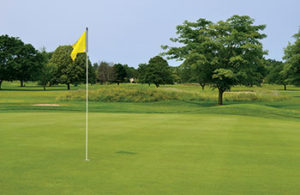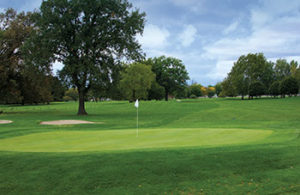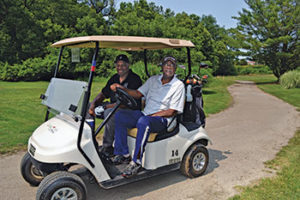Motor City Magic: Putting the spotlight on Detroit’s public courses

Rackham, Rouge Park and Chandler (pictured here) have seen generations of local golfers. One year into the revitalizations, the courses are making a major comeback. (Photo: Abby Hart)
If Detroit’s public golf courses could talk, you wouldn’t believe their stories.
The Motor City’s four major courses — Rackham, Palmer, Chandler and Rouge Park — have been graced by both local and famous golf lovers, including Motown legend Smokey Robinson and heavyweight boxing champion Joe Louis, who played in Detroit golf leagues 50-60 years ago.
In recent years, the story of public golf in Detroit hasn’t been so rosy. Until 2017, the courses were managed by a company under a short-term contract. The result was a lack of investment leading to dying greens, bunkers crowded with weeds, poor drainage, flooding, worn-out clubhouses and pavilions — and a sharp drop-off in golfers.
These conditions weren’t going to fly with Angie Hipps, contract manager for Detroit’s General Services Department, which oversees the golf courses.
Hipps isn’t a city employee bent only on managing money and resources — she cares about course conditions. She was the first female greens superintendent in Michigan when she worked at Rogell Golf Course, a former city golf course, from 1989 to 2005, before the venue closed in 2007.
The city enlisted the help of the National Golf Foundation (NGF), which investigated conditions at each of the city’s four golf courses. The resulting 152-page report was eye-opening for city officials for its hefty price tag: $15 million to repair all four locations.
There was one other thing Hipps noticed: “Most of the problems could be solved with basic agronomy practices,” she says, which indicated to her that getting the right turf professionals in place was key to saving these beloved courses.
The city opted to close Palmer Golf Course, situated in Palmer Park. (The park also houses the private-membership Detroit Golf Club, which in June hosted the Rocket Mortgage Classic to much fanfare.)
Turning its attention to the remaining three courses, NGF recommended a bridge contract with a management company to help raise the quality of turf and bring golfers back. The city chose North Carolina-based Signet Golf Associates, headed up by owner Peter Dejak, and the city allotted $2.5 million across all three courses to start improvements.

The City of Detroit superintendents have revived the greens and focused on drainage on each of the three golf courses. (Photo: Ben Neuman)
The bridge contract with Signet lasts until March 2020, when the city will move toward an extended long-term contract with a management company.
Signet receives an upfront management fee to handle the financials, but the city reimburses it for all expenses, including maintenance crew salaries and equipment. The city has final say in all purchases, management and superintendent positions and improvements. Hipps’ days often are spent crisscrossing the city, visiting the courses and meeting with superintendents, course managers and city officials. She and Dejak keep in daily contact about the progress of each course.
Dejak is a former superintendent, with stints at Augusta National, Atlanta Athletic Club and Pinehurst National. He began Signet in 1995 with golf construction and management services.
“What I find here is that I’ve never seen a group of courses that are more community oriented,” Dejak says. “The individuals that go to these courses, they really take ownership like it’s their local neighborhood. Some municipalities are like that, but this area even more so.”
It was a tough transition when Signet came on board. “The people who came (to the courses), they weren’t happy because it wasn’t what it could be,” he says. “Now, everyone’s given such great support. You’re driving the course, they’re high-fiving you, and it’s really neat.”
To oversee the management alongside Hipps, Dejak handpicked a big name in Detroit golf to become the director of golf for Signet: Karen Peek, LPGA — the first African-American LPGA professional in the United States. Peek draws on her own experience as a golfer in Detroit, starting out with her first lesson as a teenager in Palmer Park in 1960 and spending more than 30 years as a golf pro in the Detroit area.
The partnership between the City of Detroit and Signet was forged, but this year’s golf challenges posed a different problem — a snowy winter followed by relentless spring rains.
Still, since Signet began improvements in 2018, revenue is up 27 percent over all three courses from last year.
Now that the golf season is in full swing, here’s how the courses began to rewrite their story.
Rebuilding Rackham
Fifteen years ago, Doug Melton stood on Ludlow Street near No. 14 at Rackham Golf Course. He remembers pushing his young son in a stroller, walking three dogs and telling his then-wife, “If I ever get a chance, this is where I want to finish my career.” A year ago, after he got a call from Dejak, the 45-year veteran
superintendent left Shenandoah Golf Club in West Bloomfield, Mich. — a role he had for 32 years — to realize his dream of keeping greens at Rackham.
Rackham Golf Course opened in 1923 and was the first 18-hole public golf course in the state. Donald Ross designed the original layout of the course, which was amended to account for a highway expansion in 1988.
Rackham is owned by the City of Detroit, though it technically lies outside city limits in Huntington Woods. The land was donated by Horace Rackham and family, who declared that Rackham should not serve alcohol and always would remain a dry course. The Rackhams also gave 22 acres to the Detroit Zoo, which borders Rackham.
Melton has a nine-person part-time crew at Rackham, and all three courses are benefitting from a two-year contract with a complete fleet of new equipment from John Deere. “It was important to go with all new and leased equipment so we could achieve better quality turf,” Hipps says.
The golf courses have a two-year lease with E-Z-GO for golf cars with USB ports and windshields, and each course now is furnished with Toro irrigation systems. Rackham’s clubhouse received a new roof, and bunkers were cleaned out and rebuilt across all three properties.
“I want to restore the ‘roar’ back to Rackham,” Melton says. “There’s a lot of history here. I want to see people back here.”
Peek and Rackham Course Manager Lisa Owens attended the Michigan Golf Show in March to drum up buzz for the course. Rackham is the headquarters of The First Tee of Greater Detroit and involved in Youth on Course, youth golf programs, the Police Athletic League, Michigan Women’s Golf Association and Kids on the Go.
“We’re doing a lot of things with kids — ultimately, that’s as important as anything we do, keeping that interest alive and developing it,” Peek says.
She is proud to see a lot of women, and younger women especially, hitting the links regularly. “I’ve seen all these courses over a period of 30, 35 years,” she says. “My joy is seeing people play here, seeing people get excited about it and working with people who share that enthusiasm. I think that’s what makes us a little unusual — at each one of these locations, you’ll find a really tightknit group.”
Changing the game at Chandler
Ben Neuman, greens superintendent at Chandler GC, came from Inkster Valley in Inkster, Mich., a public golf course needing a lot of work to bring the turf back — not unlike the situation he now faces at Chandler. Prior to that, he spent 17 years with ValleyCrest (which became BrightView in 2014), managing golf courses in Michigan and Massachusetts.
Chandler is an 18-hole course, 6,000 yards from the tips. It’s family oriented and relatively flat and shorter than Rackham or Rouge Park. “It’s fun to play here, it’s easier, definitely seems to be more beginner golfers, and morning play tends to be really busy,” Neuman explains.
The rounds in June were up 40 percent over last year. “Next year is when we’ll get a true snapshot of how well we’re doing, because last year was all about bringing these courses back,” he says.
Chandler has received plenty of new upgrades — clubhouse renovations, pavilion repairs and overhauling bunkers all over the course. A Toro irrigation system and pump house replaced the manual quick couplers in each fairway.
The biggest undertaking for the course wasn’t even on the turf — it was clearing the densely overgrown perimeter fence line of the golf course. Trees, vines, debris, brush and the old fence were removed and carted away — a job that took 80 truckloads to complete. The perimeter was regraded, and the fence was replaced so that passersby on I-94 can see the golf course.
The team, which includes Lisa Woodcox, LPGA, golf manager, and Matt Peslis, assistant superintendent, is focused on cleaning up the natural areas, updating and expanding too-small tees and continuing work on the course’s bentgrass greens, many of which were void of turf in areas. “It’s pretty unusual to have bentgrass greens here,” Neuman says. “I don’t know if that was a result of the irrigation system not being great and struggling to apply enough water to keep Poa alive, and the bent survived.”
Getting proper drainage is the next major goal at Chandler, Neuman says. After the wet spring, most of the front nine was damaged by carts and standing water.
“It’s been a lot of work, but it’s been great,” he says. “My biggest reservation was hoping the city would follow through on its promises — new irrigation system, etc. But they’ve followed through.” Hipps adds, “As an ex-superintendent, one of the most important things to me was the product. You have to face the regulars. As conditions improve, then they expect more, and you take it to the next level. This is why I’m so excited about Ben and Doug, because they have the qualifications to take it to the next level.”
Returning the glory to Rouge
Ben Neuman liked his work at Chandler so much that when the superintendent job at Rouge Park Golf Course, 18 miles west of Chandler, became available, he asked Hipps and Dejak if he could take on that role as well.
Neuman has overseen both Chandler and Rouge since May, alternating his days between the two. He brought Eric Schmith, who worked with him during his ValleyCrest days, to Rouge this past March. What enticed Schmith? “A new course,” he admits. “I had 18 years at one course — here, everything’s new, everything’s a challenge. Every day is new again.”

Longtime Rouge Park golfers James “Big House” Williamson (right) and T.J. Hemphill are floored by the course’s new look. (Photo: Abby Hart)
Neuman and Schmith have a team of 12 part-timers who support them, and Schmith is open about the labor struggles. “It’s about taking what I can get out of (the crew) and hiring extra. If one or two don’t show up, then I have one or two that will.” For Chandler and Rouge, the City of Detroit prefers they hire Detroit residents to work on the crews.
Darwin Beatty, a native Detroiter, has been at Rouge since 1988 — through four different management companies — and is a jack-of-all-trades at the course. He started playing golf in 1968 at Rackham, Palmer and other Detroit-area courses, then came to Rouge. “I got allergic to paying greens fees, so I started working here as a ranger and a starter,” he laughs.
Beatty notes that prior to last year, “Weeds were everywhere on the course, and we almost lost the greens, but they brought those back. We went through a lot here with floods, and (Signet) has a done a remarkable job stopping the flooding.”
Rouge’s biggest capital improvement is the drainage system. The Rouge River runs through the course, and Signet installed catch basins for flood water. The next order of business will be to install a pump in the Rouge River so the course isn’t reliant on city water.
Cultural work continues on the greens, six bridges were replaced, drainage installed and a new enclosed pavilion was erected for the many leagues that play at Rouge.
Nick Macy is a veteran of the golf world, with 26 years under his belt, and a veteran of Rouge Park, having worked at the course from 2005-2010. “Our biggest complaint this year is that there are too many people coming,” he jokes. He gestures to the longtime league players around the clubhouse, referring to them by their nicknames. “Sugar Ray, Shotmaker, they’ve all been here forever. Some of the players here are amazing because they play almost every day.”
James “Big House” Williamson has been playing at Rouge for 20 years and T.J. Hemphill for 10. “We have a 48-man league here on Thursdays in the summer,” Williamson says. “It feels really competitive to other courses now, which is great. These guys came in like gangbusters to make it beautiful and playable,” Hemphill says. “We golf everywhere, but this is home.”










